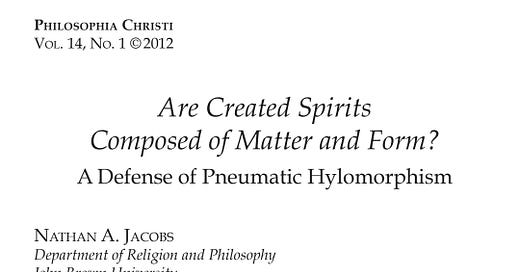Making Sense of the Intermediate State
In a traditional eschatology, whether one considers the distinction between the two judgments to be conceptual (atemporalist) or concrete (nonatemporalist), any coherent postmortem anthropology requires some form of embodiment per a universal hylomorphism, along with a corporeal general resurrection.
Some interpret the 2 judgment distinction mereologically, in parallel, where the general refers to the sum of its parts, i.e. individuals' particular judgments & resurrection (Rahner). Others conceive the particular resurrection as undoubtely embodied but becoming enhanced or completed at the general. The latter's consistent with the truth that "the individual can attain perfect fulfillment only when all the others have also attained to perfect fulfillment” (Walter Kasper).
The Franciscans (Scotus & Bonaventure) hold the keys to any coherent angelology, so maybe they can shed some light on how contingently dis/carnate persons can, like angels, be both embodied & incorporeal? One key is that all finite causes must be together, spatially, to produce an effect.
I made up a little heuristic b/c Scotus departs from TA in many regards:
1) in/communicable essence? all essences, divine & creaturely are communicable
2) dis/embodied? all creaturely entities are naturally embodied (communicatability & spatial extendability) composites of forms & matter, the latter which, as a part & principle of composite being, is an entity in act
3) in/animate? some entities are animate & some animate entities are agential
4) in/corporeal agents? angels & contingently dis/carnate souls are incorporeal
5) im/material? agential formal causes are immaterial
6) presence spatially located?operationally (Aquinas) or per se (Scotus)?
Certainly, many questions still beg. For those who want to further explore those questions, consider Jacobs' article (pdf link below).
http://www.newdualism.org/papers/N.Jacobs/Jacobs_PC_vol_14_no_1_(pneumatic_hylomorphism).pdf
While I am largely resonant with Jacobs’ pneumatic hylomorphism, both regarding the intermediate state & anthropology in general, because my own emergentist account remains agnostic vis a vis root metaphors & primitives (and eschews specifications like strong & weak supervenience), I’m not inalterably opposed to a nonreductive physicalist account of the soul. If that turns out to be the case, I would then just reinterpret our particular judgment & resurrection in incorporeal terms and the general as robustly corporeal. By robustly I refer to the New Earth. I also don’t have any quibbles with haecceity, especially as needed to individualize spiritual persons (with Swinburne I’d agree that material realities might be particularized spatially), but agree with Jacobs that something more is needed, which is why I employ a Peircean-inspired triadic modal ontology, which better accommodates conceptions like energeia, secondary natures, formal acts, etc It’s not inconsistent with my anthropology to ground our immortality in either objective or subjective terms or even both, as long as we are ultimately resurrected with both our pneumatic & corporeal being.
The early patristic writers, the Cappadocians, Damascene & Eastern fathers all approached notions of personhood more in continuity with Bonaventure's universal hylomorphism, in general, & Scotus' haecceity, in particular (see what I'm doing, here?), than with Thomism's Aristotelian conception of the soul as the form of the body.
We must go beyond a person's primary nature & haecceity to further account for the dynamical aspects of secondary natures vis a vis becoming (treptos, tropos, theosis, virtuosity & viciousness). That's to say we need a locus of mutability that distinguishes the essential (operative) and agential (operator) from energeia (operations) and their formative effects (operated). Here, I employ a triadic modal ontology (inspired by Peirce).
It is true that modern anthropologies, like emergentism plus supervenience, don't advance our understanding of consciousness, premortem much less postmortem. But to say, per any competing accounts, whether the soul is intrinsically immortal or not is to prove too much. For example, there's no distinct confessional advantage (or secular cachet to be gained, either, for that matter) by adopting either a panpsychism or nonreductive physicalism.
This is not to deny that there are distinct advantages to be had by affirming a pneumatic hylomorphism for both our angelology & postmortem anthropology vis a vis the intermediate state. It's only to recognize that, among other things, for example, we can't say whether it's necessarily an exclusively subjective or an objective-subjective immortality in play, again, whereby we’re ultimately resurrected with both our pneumatic & corporeal being.
For those who want to explore what the distinction between dis/embodiment & in/corporeality might mean & how it might play out, more existentially, I recommend this:
See Ed Feser’s Defense of Survivalism for a nuanced Thomistic take. I’m unsure what implications that take might mean for Aquinas’ angelology, though, vis a vis immutability.





